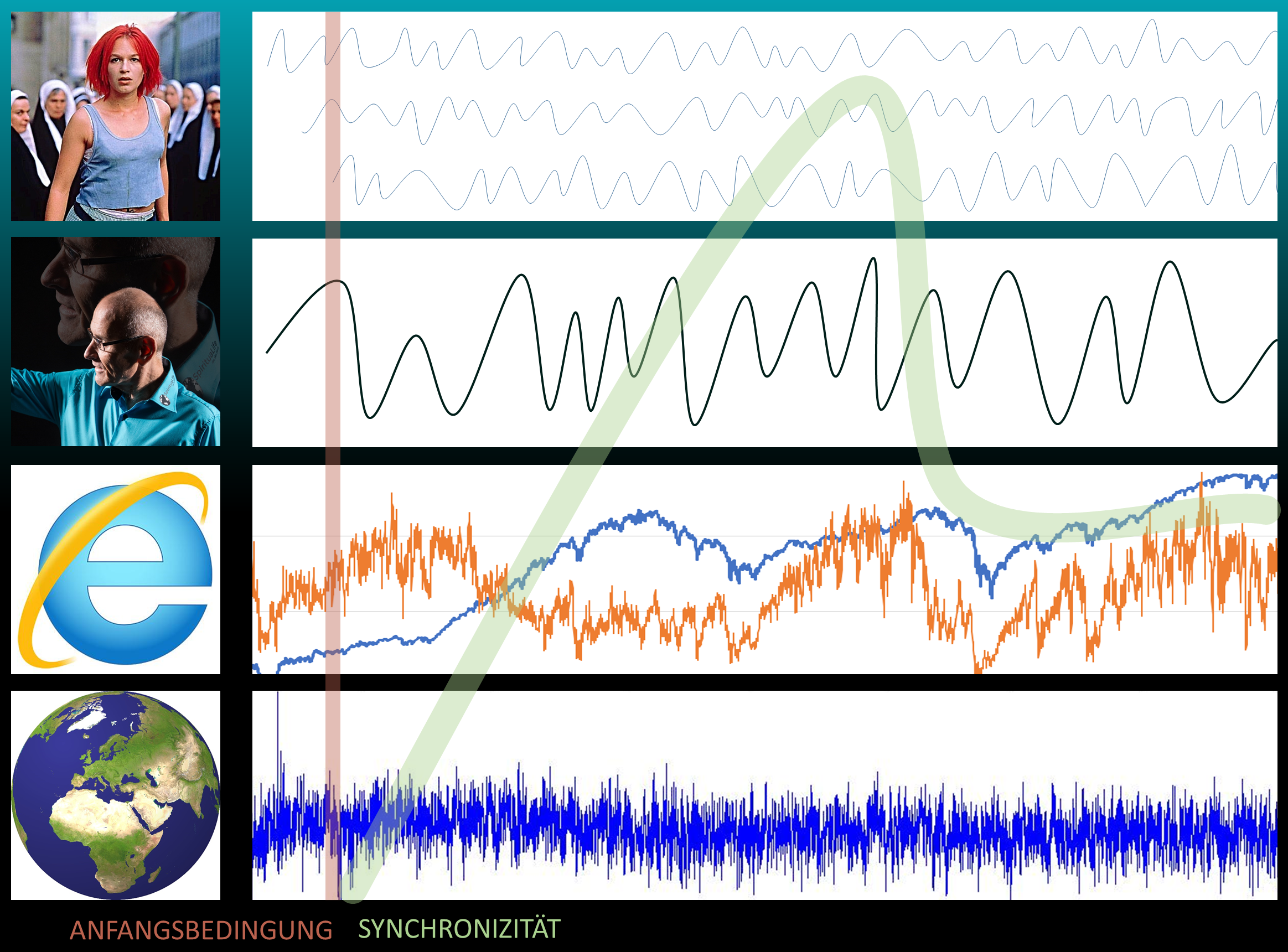Spirit in the Cloud Part 6
Lola runs – Content summary
- Lola has a friend named Manni out of the criminal Milieu.
- Manni smuggles and washes diamonds for his dealer.
- When he loses a bag with 100,000 DM – the story Begins.
- After a phone call, Lola races to get the 100,000 DM. It takes exactly 20 minutes.
- This period from 20 to 12 is now played three times – with only minor changes.
- The first run is, as we believe, destined destiny.
- The second and third barrels are slightly offset in time. It always starts at the same time. However, it is hindered in the stairwell to varying degrees.
- Well recognizable at the exit of her father’s car. It’s about half a car’s length.
- Smallest changes in the beginnings change the entire course.
- There are six encounters: dog, woman with baby carriage, cyclist, service car, sandler and rescue vehicle.
- At the respective ends is once Lola dead, the next time Manni and at the third run is everything o.k. – nothing has happened.
When I stand in the kitchen at the electric stove and watch the boiling water as it produces air bubbles, I come to the conclusion that these happen by chance and behave chaotically. There are many examples of this kind in nature (meadows, snowfall, clouds, ants, etc.). Such phenomena also arise in socio-technical systems. The traffic would be about. Especially on German highways one can observe this. You go there for a long time and once more and then again less traffic – very coincidentally. But suddenly, as from nowhere, a traffic jam is created, which is then quickly over again. It was neither a construction site nor a speed limit, but the traffic jam was still. Then one thinks that this had to have a cause. Is not everything so random and chaotic – but is there a cause that we may not know? In the case of the traffic jam example, it has been shown in the meantime that a driver at high speed was only briefly inattentive and braked. The consequence is that the descendant also brakes, but already somewhat stronger. This in turn leads to a chain reaction which can lead from 160 km / h up to the step tempo. Larger distances or driving in groups, as ants do, could help. Cars with artificial intelligence would have installed such a thing anyway.
Does God also have a boiling soup pot, into which he looks, and looks as random and chaotic as the bubbles rise and burst at the transition? One of them had climbed 14 billion years ago, burst, steamed, and condensed again. That’s what we call the Big Bang. A random event – in addition to countless others. Even after the Big Bang, chance is still the dominant principle and we call it evolution. This brings me to the decisive question: is in our life all coincidence, do we have our own will, or is everything predestined (determined) anyway? “Lola rennt” is a film that takes on this theme.
Lola has to solve a task, namely DM 100,000 within 20 min. This action is shown with three, only minimally changed starting conditions. After Lola’s friend Manni described her problem on the phone and she understood it, she runs. As far as three times the same. The difference begins in the stairwell. There is a man with a dog. Once, she stops briefly, the second time the man puts the leg and she stumbles and the third time she just jumps over the dog. This results in only minor differences in time. An action that takes its beginning in a time lag of only a few moments. Our linear cause / effect thinking would suggest that Lola is either too early or too late. The proverbs: “Whoever comes late punishes the life” or “Only the early bird catches the worm,” say so what. Negative experiences from a late arrival we remember. However, as often happens, there is little – or say, “Once again good”.
Lola runs off. The temporal misalignment becomes recognizable in the encounters with different persons. Most clearly at the exit of her father’s car. This is about half a car length. The first time she just comes by. However, the driver (recognizes Lola) is distracted so far that he subsequently caused an accident. Again coincidentally with that car, which belongs to the dealer the Manni the money owes. Complexity arises from the fact that the actual action is dependent on side and far-reaching effects. Inattention of the chauffeur is the side effect which leads to the accident. The distance is aimed at the handing over of the money to which the dealer then comes too late or not at all. On the second run the service car has already gone so far that Lola has to jump over it. The vehicle of the dealer is only slightly damaged, connected probably less remote. The third time, Lola landed on the bonnet. In the meantime the vehicle of the dealer passes without accident, so no side-effects and long-distance effects.
Each action in complex systems has secondary, remote and time-delayed effects.
However, Lola’s encounters have not only physical effects. Depending on the time at which Lola meets the other people, she dissolves different thoughts. The woman with the baby carriage says: “Make your eyes on you bitch” and remembers something past. In the second, she solves the idea of winning a lottery and the third, a death. Depending on the mental state we encounter other people, the most varied is the one that is not in our control. If we have to go to a particularly unpleasant date, we expect it to happen. But it can also be quite different, depending on which “state” the other is straight. Formal courtesies, own clothes, the SmallTalk, etc. have less influence. What is even more significant is what was just before and how the emotional state of our counterparty is set. In particular, there are relationships which have a great effect. Lola is also confronted with this problem.
Lola decides to lend the money from her father, a bank manager. About the time when Lola ran, he and his beloved had a “scene” in his office. She reproaches him: “How long will this continue with our homilies, let yourself finally divorced and in addition I get a child”. Lola comes in now. She has no chance to make her father understand the problem. This is not due to it, but to its current state. Finally, he throws Lola out. On the second run, the beloved says, “I am pregnant; Do you want a child with me, even if it is not from you? “So he has even less understanding for Lola and she robbed the bank to get the hundreds of thousands. In the case of the third, the lived only said: “We get a child”. Daddy said, “This is the most beautiful thing you ever told me” and drive away with the company car. Lola is too late, even though she was early.
Human interactions and relationships can be very emotional, take time, and lead to non-linearity. Irrational decisions are made; In the positive (love) as in the negative (hatred). In the Hindu tradition, the attachment is mentioned in this context. As little as possible, in as many situations as possible, is the commandment.
“Lola runs” shows that the smallest changes in the initial conditions change the entire event chain. Once Lola is dead, the next time Manni and with the third nothing happened. Many wisdom books recommend us to pay close attention to these trifles. But what exactly are the smallest causes that lead to such a great change? Yes, if we knew that, life would be easy. We could be waiting for exactly these moments and then making the right decisions. This is not the case, however, because the unimportant always happens at every moment. So what makes the difference? This has always been the focus of esoterism. Astrology, I Cing, Tarot, etc. tell us when we need to pay attention to something very special. Dreams were also used. Even if we dismiss all this in our culture as “spinning,” we sometimes get the impression that things happen in an inexplicable way. When I dream and the next day happens something or at least something very similar. One thinks of a person and one meets them immediately. At Lola it is the moment when the father is no longer available for money and she stands in front of a casino. The Father’s mission is not causally related to the location of the casino.
Already the psychologist C.G. Jung has dealt with such phenomena and called them “synchronicities”. These are connections which do not have a real cause-effect relation but have a substantive reference to such a connection. I watch a movie and see a dove walking past a window while I see a bird at my living room window. According to my understanding there is no connection. Some people happen to do this more frequently, others rarely to none. It is, of course, connected with the awareness and attention for such phenomena. But it is more than that. Whoever lives in a differentiated environment experiences synchronicity more frequently than someone who moves in a constant standard. Travel, many relationships, several places of residence, etc., were, at least in the past, such enrichments. Today in the multimedial, digital world, these environments are becoming more potent. With social media I have a lot of “friends” watching about movies and series so far inaccessible content. These will soon be visible in 4K quality visually no longer distinguishable from reality. Especially with VR glasses it comes to a blurring. If I can no longer distinguish VR from RR, I can no longer tell virtual cause of real effect. As a result, synchronicity according to Jung will become even more important.
Synchronizations could also be used to find precisely these very small causes, which then lead to great effects. This methodology is in no way empirically proven. It is merely a theory that could be tested in self-experiments. Whenever one recognizes such an incoherent context one should pay more attention to such situations. Lola ran three times past Sandler, who had the sack with the hundred thousand. She should have taken him. Concentration on the one goal has, however, limited their attention to it too much.
Synchronizing enriches our lives, shows us the same situation in different contexts, and frees us from the cause-effect thinking.




 Deutsch
Deutsch English
English